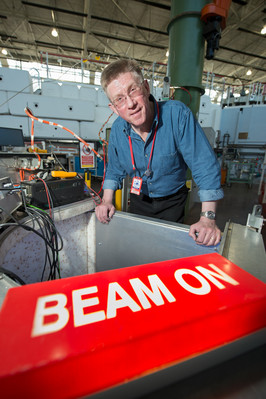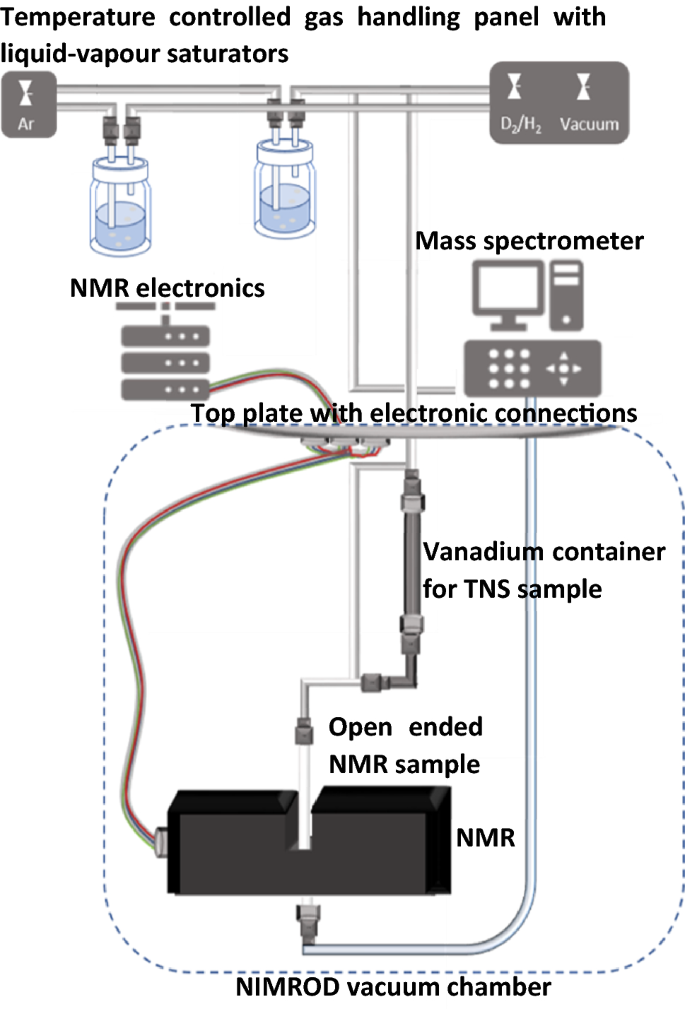When studying catalysis, neutron scattering acts as a complementary tool to methods such as X-ray diffraction and electron microscopy, but it can also provide information that is not available through study using other techniques. Researchers from across the globe have used the instruments at ISIS to gain a unique insight into catalysts used in a wide variety of reactions.
Inelastic neutron scattering (INS) is a form of vibrational spectroscopy that relies on the scattering of neutrons by the atomic nucleus. This means that it is not subject to any optical selection rules, like those relevant to infrared and Raman spectroscopy, and therefore all vibrations are measurable, in principle.
In their study featured in the special issue, Longfei Lin and colleagues focus on the application of INS to investigations of the behaviour of hydrocarbons on metal-oxide and zeolite catalysts and the formation of hydrocarbon species on the catalysts used in methane reforming (combining water and methane to produce hydrogen) and the Fischer–Tropsch process (the reaction of a mixture of carbon monoxide and hydrogen, known as syngas, to produce diesel). To see how these reactions fit into the wider field of environmental chemistry, see our Green Catalysis infographic.
Another Fischer-Tropsch catalysis study included in the collection, led by the 2021 ISIS Impact Award winner David Lennon, combines ex situ and in situ INS measurements. Using the MAPS instrument at ISIS, the group studied the effectiveness of a promoted hematite catalyst, observing the formation of a hydrocarbon-containing layer that dictates the selectivity of the catalyst for low molecular weight olefins.
 The ISIS 2020 Impact Award winner Peter Albers from Evonik Operations GmbH (pictured, left), in collaboration with ISIS scientist Stewart Parker, used INS to measure the in-situ hydrogenation and dehydrogenation of commercial palladium-based catalysts, as part of another study in the collection.
The ISIS 2020 Impact Award winner Peter Albers from Evonik Operations GmbH (pictured, left), in collaboration with ISIS scientist Stewart Parker, used INS to measure the in-situ hydrogenation and dehydrogenation of commercial palladium-based catalysts, as part of another study in the collection.
Also featured is a collaborative study between Stewart Parker, Peter Albers and David Lennon, along with colleagues from the universities of Glasgow and St Andrews, and Evonik Operations GmbH. This study used INS on Tosca and MAPS to investigate a series of supported and unsupported nickel and cobalt catalysts, candidates for the Fischer-Tropsch process.
“Because neutrons 'see' hydrogen so well, they provide a different, and unique, perspective on a catalyst" explains Stewart Parker.
Zeolite catalysts are also widely used in industry; their open framework means they have a large surface area, a key required characteristic. They also have tunable acidity and size selectivity, giving control over which reactants will fit inside their pores.
H-ZSM-5 zeolite was one of the first used for the methanol to hydrocarbon reaction. A collaboration between the universities of Glasgow and Aberdeen and the chemicals company Johnson Matthey used Tosca and MAPS at ISIS to study the mechanism of methanol adsorption on the catalyst, and how different techniques appear to give different answers.

Above: Schematic of methoxylation reaction occurring when methanol is introduced into an acidic zeolite catalyst
As well as INS, quasi-elastic neutron scattering (QENS) has also been used to study H-ZSM-5. Researchers based at the Research Complex at Harwell used the OSIRIS beamline to study H-ZSM-5 both with and without methanol loading. Using variable temperatures, they were able to study the dynamics of the adsorbed methanol in the system.
Lignin is a primary constituent of biomass, with the potential to be used both as a fuel and as a source of chemical for industry. After an initial de-polymerisation step, a process to transform the products of this into a useful feedstock is required. A possible catalyst for this transformation is zeolite Beta, which was the subject of a QENS study that also features in this special issue. The study looked at the dynamics of the compound catechol, comparing measurements to computational studies, characterising the rotational motion of the catechol when inside the pores of the catalyst.
As well as studying catalysts, and the compounds involved, at specific points during the reaction, recent progress has enabled the use of operando studies, which enable the study of reactions as they progress. In collaboration with ISIS scientist Ian Silverwood, researchers from Johnson Matthey and the Universitiy of Strathclyde followed the complexation of NiCl2 with 2,2′‑bipyridine using the QENS instrument IRIS. In another experiment, researchers from the University of Glasgow and Johnson Matthey also collaborated with Joe Kelleher, using the Engin-X instrument to study the strain induced in the aluminosilicate structure of the catalyst chabazite during water adsorption.
“Neutrons are a great tool to investigate catalysts as they can penetrate deeply into samples and give us information not available with other techniques," explains Ian Silverwood; “We are interested in how chemicals are changed in a reaction but it can be difficult to 'see' because the catalysts interfere. Neutrons can make the catalyst virtually disappear and give us a better view of what is happening."
 Another neutron technique described in this special issue is an integrated total neutron scattering and NMR method. Using the NIMROD instrument, researchers from the universities of Manchester and Cambridge studied in situ the hydrogenation of benzene to cyclohexane when confined in the pores of MCM-41 as a substrate for a platinum catalyst. The combination of techniques enabled them to get an accurate characterisation of the cyclohexane:benzene ratios. This gave them an unprecedented picture of the structure and orientation of the molecules in the mixed liquids both in the confined system and compared to the bulk liquid.
Another neutron technique described in this special issue is an integrated total neutron scattering and NMR method. Using the NIMROD instrument, researchers from the universities of Manchester and Cambridge studied in situ the hydrogenation of benzene to cyclohexane when confined in the pores of MCM-41 as a substrate for a platinum catalyst. The combination of techniques enabled them to get an accurate characterisation of the cyclohexane:benzene ratios. This gave them an unprecedented picture of the structure and orientation of the molecules in the mixed liquids both in the confined system and compared to the bulk liquid.
This special issue highlights the importance of neutrons in catalysis studies, showcasing research at ISIS and other neutron facilities across a range of applications and industries.
Image, right: Schematic of Flow Neu-NMR set-up used for the NeuNMR study of confined benzene: cyclohexane liquid mixtures
Further Information
The full issue can be found online at Topics in Catalysis, 64, 9-12
The journal articles featured in this summary can be found at:
Investigations of Hydrocarbon Species on Solid Catalysts by Inelastic Neutron Scattering, DOI: 10.1007/s11244-020-01389-7
Applications of Neutron Scattering in Technical Catalysis: Characterisation of Hydrogenous Species on/in Unsupported and Supported Palladium, DOI: 10.1007/s11244-021-01424-1
An Inelastic Neutron Scattering Investigation of the Temporal Behaviour of the Hydrocarbonaceous Overlayer of a Prototype Fischer-Tropsch to Olefins Catalyst, DOI: 10.1007/s11244-021-01419-y
The Characterisation of Hydrogen on Nickel and Cobalt Catalysts, DOI: 10.1007/s11244-021-01425-0
A Spectroscopic Paradox: The Interaction of Methanol with ZSM-5 at Room Temperature, DOI: 10.1007/s11244-021-01462-9
Operando Neutron Scattering: Following Reactions in Real Time Using Neutrons, DOI: 10.1007/s11244-021-01436-x
Methanol dynamics in H-ZSM-5 with Si/Al ratio of 25: a quasi-elastic neutron scattering (QENS) study, DOI: 10.1007/s11244-021-01450-z
Quasielastic Neutron Scattering and Molecular Dynamics Simulation Study on the Molecular Behaviour of Catechol in Zeolite Beta, DOI: 10.1007/s11244-020-01400-1
Bulk and Confined Benzene-Cyclohexane Mixtures Studied by an Integrated Total Neutron Scattering and NMR Method, DOI: 10.1007/s11244-021-01437-w
